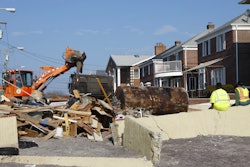While the full economic impact of back to back hurricanes is yet to be determined, estimates for Harvey alone have spanned broadly from $70 billion to as much as a $200 billion, as various agencies struggle to assess the damage from the storm and subsequent flooding. It will be weeks before even marginally accurate estimates come out and, as past storm history shows, years before the final board is in place in the rebuilding process.
History also demonstrates both positive and negative sides to disaster recovery for the construction sector — both of which are likely to be exacerbated by the severity and frequency of the storms. For firms willing to assume the potential risks and logistical challenges (see Running the Business, p. 46), the rewards associated with cleanup operations and subsequent rebuilding can be substantial. For others, the coming months portend to be less profitable as these activities consume resources originally destined for other projects. Prices on certain types of building materials were already on an upward trajectory prior to Harvey and Irma, and the recovery could accelerate this trend.
[VIDEO] Hurricane Harvey Recovery Shifts to Reconstruction
Consider softwood lumber, the predominant building material in new home construction. According to the National Association of Home Builders (NAHB), its price has risen 22% since January 2017, when the Trump administration announced plans to place added tariffs on Canadian lumber imports. Prices for related wood products, such as plywood and gypsum, also rose marginally.
Homeowners and homebuilders in storm-affected areas have already seen sizable added price hikes for these materials. As repair and rebuilding continues, and the threatened tariffs go into effect, it’s inevitable that supplies will tighten and costs jump across the U.S. Add to this current expectations for continued strength in total construction activity and prospects for greater federal infrastructure investment, and there could be further strain placed on limited supplies of these and other materials that continue to drive up pricing.
Of course, there is also the ongoing skilled labor shortage. The Associated Builders and Contractors estimates a shortage of 1 million+ tradespeople — a figure that does not take into account the impact of rebuilding in Texas and Florida. This estimate is substantiated by a study sponsored by the Associated General Contractors of America and Autodesk, and released earlier this year, that indicates 70% of construction firms are having a hard time filling hourly craft positions.
How Hurricanes Affect Construction Jobs
The NAHB estimates 10,000 to 20,000 workers may be needed to rebuild homes damaged by Harvey. This represents 10% to 20% of the residential construction workers in the Houston metro area. And while the shortages will be felt most in Texas and Florida, the ripple effects could extend much further as firms in affected areas raise wages to attract the needed workforce, and subsequently influence labor costs across the country.
At this point, it’s too early to say to what extent construction costs will be impacted. This means it’s vital to monitor conditions nationally and in your area for pricing trends so you can build any notable increases into future bids. Also take time to review your company’s recruitment efforts, as well as its compensation package to ensure it remains competitive.
Place your business in the best possible position to maintain both profit margins and the workforce needed to complete projects on time and on budget going forward. That way, there’s less chance you’ll be caught in the flood of likely higher project costs ahead.

















